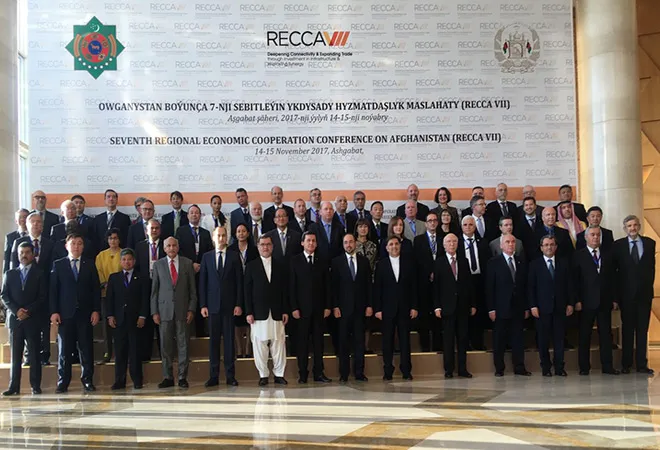
Landlocked countries like Afghanistan are at a great disadvantage over their littoral neighbours with access to sea for regional and global trade. Naturally, the peace, security, and prosperity of landlocked countries depend on those of their surrounding neighbours. Since the fall of the Taliban in 2001, the Afghan government has repeatedly communicated this fact to Afghanistan’s six neighbours, reaffirming its commitment to non-interference in the affairs of others, as well as allowing no country to use Afghanistan’s soil against its neighbours.
On this basis, on December 22, 2002, Afghanistan and its six neighbours signed the Kabul Declaration on Good Neighborly Relations. The signatories included China, Iran, Pakistan, Tajikistan, Turkmenistan, and Uzbekistan—each of which “determined that the people of Afghanistan should enjoy security, stability, prosperity, territorial integrity, democracy and human rights after so many years of conflict, suffering, and deprivation.”
Even so, however, interstate tensions among Afghanistan’s coastal neighbours or some of these countries’ hostility with countries outside of the region have undermined efforts at stabilising Afghanistan and giving its people a break from decades of non-stop conflict, displacement, and continued impoverishment. Despite these obstacles, Afghanistan has lost no opportunity to draw the attention of its neighbours and major global powers to the centrality of Afghanistan’s location at the heart of Asia and thus its immense geo-economic importance to regional economic cooperation and integration.
Cooperation over confrontation
Afghanistan is concerned about the lingering tensions and hostility between India and Pakistan, and have often encouraged both sides to set aside their differences and focus on win-win cooperation. Their shared experience has demonstrated that confrontation has only bred more violence and deepened hostility, preventing the two resourceful nations from unlocking and harnessing their shared potentials for bilateral and multilateral trade and investment. Academic studies abound on how much India and Pakistan have lost in economic and financial terms each year for many decades.
This counter-productive relationship has rendered ineffective the South Asian Association for Regional Cooperation (SAARC). SAARC drives its inspiration from the European Union (EU) and similar entities, which—following decades of pursuit by their future member-states of lose-lose policies against one another—were formed. Indeed, the harsh experiences of European states in the 19th and 20th centuries before the two World Wars are quite instructive for South Asia: Europe learned the hard way the benefits of win-win cooperation against the perils of zero-sum designs and power politics that underpinned inter-state relations in pre-war Europe.
In the 18th SAARC Summit in Nepal, member-states debated the many common challenges that confront the nations of South Asia. Extreme poverty, weak governance, a lack of connectivity, a lack of energy, and security threats continue to cause widespread human suffering throughout the SAARC region, a region otherwise richly endowed in nature and civilization. To address the root-causes of these problems and to exploit the region’s vast natural and human potential for the collective security and prosperity of all their nations, Afghan President Ashraf Ghani called on his fellow SAARC leaders to “change the rules of the game and the playing field among the nations from confrontation to cooperation.”
While continuing to advocate for cooperation against confrontation among its neighbours, Afghanistan has consistently pursued a foreign policy, which promotes regional economic cooperation against zero-sum hedging strategies pursued by some of its neighbours. It strongly believes that the replacement of confrontational policies at the regional level with those of cooperative, win-win partnerships would gradually minimise Indo-Pakistan tensions. This is premised on the fact that South Asia is an extremely young region where the youth demand jobs and a secure future. And this wouldn’t come by, unless South Asian governments make tough choices against the status quo to help ensure shared prosperity and security throughout the region.
Connectivity achievements
Since the fall of the Taliban, Afghanistan’s basic transport infrastructure in urban and rural areas has seen a makeover, which needs to be maintained and improved upon. Most notably, the Afghan National Ring Road, which connects the center with periphery and the periphery with Afghanistan’s neighbours, has been completed. On the soft side, the World Bank’s 2013 Doing Business Index ranked Afghanistan 28 out of 185 countries when it comes to establishing a business in the country.
And over the past 16 years, the Afghan government has enacted a number of commercial and investment laws, including a company law, consumer protection law, competition law, partnership law, and arbitration law, among others. This legislation has streamlined many of the problems associated with Afghanistan’s former centrally planned economy. Moreover, in an effort to attract, facilitate, and retain long-term investment, the reforms agenda of the new National Unity Government of Afghanistan has prioritized the resolution of existing bottlenecks to ensure a business-friendly environment across Afghanistan.
Challenges and opportunities
The principal challenge to building in and utilising connectivity through Afghanistan is manufactured insecurity in the form of a well-resourced terror campaign imposed on Afghanistan. The Taliban-led terror campaign has provided an enabling operational space for over a dozen other terrorist networks, including ISIS. Fighting this scourge of regional and transnational terrorism has not only undermined the security needed for the implementation of many ongoing and proposed connectivity projects but also sapped Afghanistan’s few precious resources to finance its planned connectivity projects.
Despite the security challenges, Afghanistan has put forth a strategic solution for adoption and implementation by its near and far neighbours: The Heart of Asia–Istanbul Process (HOA-IP) and the Regional Economic Cooperation Conference on Afghanistan (RECCA). These Afghanistan-led processes were established to help secure regional cooperation for the country’s stabilisation and sustainable development, thereby ensuring stability and prosperity throughout its surrounding regions.
Even though they remain underutilised so far, it is in the best short-and long-term interests of the countries — including India and Pakistan — that participate in the two processes to double and triple their efforts to achieve the shared goals of the two platforms. Of course, every tangible step they take to utilise these interconnected processes will help minimise these and other nations’ security and socio-economic vulnerabilities against the terrorist-extremist predators and their state-sponsors. That is why time is of essence and they must reaffirm their often-pledged commitments to the implementation of the projects and programmes, proposed under the two processes.
On November 14-15, the 7th meeting of RECCA took place in Ashgabat, Turkmenistan. The meeting focused on “Deepening Connectivity and Expanding Trade through Investment Infrastructure and Improving Synergy.” This was a timely opportunity for Afghanistan’s near and far neighbours to take stock of the progress made since RECCA VI in Kabul. The meeting, with many side events, allowed the country-participants to discuss the challenges and bottlenecks, as well as financing and investment needs with respect to the priority projects in the key areas of energy; transport networks; trade and transit facilitation; communications; and business to business and labor support.
More specifically, of the 18 regional cooperation and investment projects discussed at the RECCA-VII, the following stand out as major opportunities for further strengthening connectivity across South Asia, Central Asia, and South West Asia: TAPI Pipeline; CASA-1000; TAP-500; Belt-and-Road Initiative; Lapis Lazuli Transit, Trade and Transport Route; Chabahar International Transport and Transit Corridor; Five-Nation Railway Corridor; Afghanistan Rail Network; Trans-Hindukush Road Connectivity Project; and Digital Silk Road.
Moreover, this past December, the 7th Ministerial Conference of HOA-IP with its political, security, and economic confidence building measures (CBMs) implementation mechanism took place in Baku, Azerbaijan. Afghanistan has aimed at deepening synergies and complementarities among the interconnected projects of the RECCA and HOA-IP, maximising their impact on sustainable development not only in Afghanistan but also throughout its surrounding regions. This should encourage the country-participants, including India and Pakistan, to assess their shared security and development needs and to bolster their engagement with Afghanistan accordingly, in order to initiate the implementation of the proposed projects with win-win benefits.
US South Asia strategy
Considering the aforementioned opportunities for increased regional connectivity across the Heart of Asia region, the centre of which is Afghanistan, the Afghan government has welcomed the new South Asia strategy of the United States. The strategy promises to remove the principal obstacle that sits in the way of building the necessary connectivity infrastructure in energy, transport, and communications, which South Asia, Central Asia, and South West Asia need, in order to integrate for trade, investment and tourism, the benefits of which should help Afghanistan and its neighbours prosper together in peace and harmony.
In this light, the Afghan government renews its firm commitment to addressing the state-to-state tensions that exist between Afghanistan and Pakistan. An end to this undeclared hostility should lead to closure by Pakistan of all safe sanctuaries and related support infrastructure, which the Taliban and their affiliated networks have enjoyed using to terrorise Afghanistan, thereby undermining regional stability and international peace. Indeed, it is in the best long-term interest of Pakistan to disengage from state-sponsorship of terrorism at the cost its sustainable security and development in a region of much potential and promise.
The views expressed above belong to the author(s). ORF research and analyses now available on Telegram! Click here to access our curated content — blogs, longforms and interviews.




 PREV
PREV


